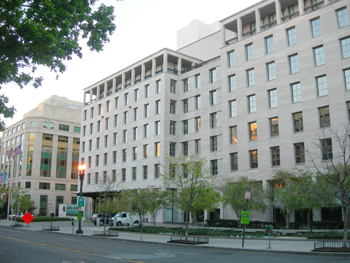AFL-CIO to Upgrade Headquarters
 WASHINGTON — The AFL-CIO, the umbrella federation for U.S. unions, will take a major step in its Commitment to Action campaign by officially starting an energy-efficient retrofitting of its headquarters in Washington, D.C.
WASHINGTON — The AFL-CIO, the umbrella federation for U.S. unions, will take a major step in its Commitment to Action campaign by officially starting an energy-efficient retrofitting of its headquarters in Washington, D.C.
AFL-CIO President Richard Trumka and AFT President Randi Weingarten announced the organization’s Commitment to Action at the Clinton Global Initiative America meeting in June 2011. The plan encourages both workers’ capital and skilled labor to participate in large-scale infrastructure investments of $10 billion over five years in hopes of stimulating job growth across the country.
Through a partnership with the International Brotherhood of Electrical Workers, the AFL-CIO committed $4.8 million to update its own headquarters. Construction on the project is scheduled to begin at the end of June or early July, with completion slated for end of 2013. The project is being managed by McKinstry, an energy services corporation with offices throughout the U.S.
There are two goals for the construction project, according to Tom Bowen, director of McKinstry’s Federal Business Unit. The first goal for AFL-CIO is to “drive energy efficiency and to help fund that energy efficiency through the savings that are generated in the building,” he said. “[AFL-CIO] would like to demonstrate that there’s a model of savings that exists within an existing building and to take those savings and help fund the project so they have a savings stream with the project that has a direct impact in the operating budget that will help offset the financing they need to achieve.”
The second goal, Bowen said, is to demonstrate that the project can create work opportunities for contractors and be a model for future projects. “If the AFL-CIO can complete this project and put contractors to work in a program that allows savings to fund the project, then that can be done in a private and public sector,” he said.
The retrofit will replace and upgrade the existing windows, as well as add a new lighting system, to make the building more energy efficient. The boiler and heat systems will also be optimized and water conservation steps are being done. Once completed, the building’s efficiency will increase by 20 percent, save more than $125,000 per year in utilities and have created more than 30,000 hours of skilled construction work.
There are also trainings for existing building occupants to use the building at its most efficient level. Some of that involves training on how to maintain a schedule or recycling program, as well as reminders on when to turn off lights and computers, which will help improve the overall efficiencies of the building.
With a broad project that involves multiple steps on an existing project, Bowen said that “solid construction management and communications plans” are going to be key in order to make sure there are no surprises throughout the construction process.
The headquarters project was always intended as part of the commitment that was made in 2011, but because of the complexities of the building’s operations, the planning process has taken time and involves integral work beyond “just skimming the cream off the top,” Bowen said. “The opportunity to unlock these retrofits within the facilities goes beyond just the lowest hanging fruit and creates opportunities that dramatically improve the infrastructure of the facility. This project represents that, through a creative approach and creative contracting, you can get in and really address retrofits. And in doing so you can promote work.”
Aside from the headquarter renovation, the AFL-CIO committed to at least $40 million to the development of the commercial and industrial energy efficiency retrofit market in the U.S. It also committed to upgrading the skills of 100,000 tradespeople and enrolling 40,000 more apprentices.
